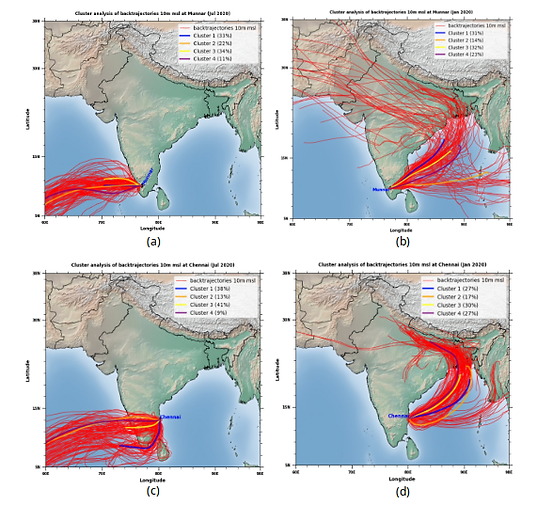
Ph.D. Research Work
Investigating long-term characteristic properties of atmospheric aerosols: interactions of seasonal changes, microphysical and chemical properties
The project aims at understanding the role of ambient aerosols in modulating the regional climate under contrasting environmental conditions in the Indian subcontinent. In this wok, we have studied the microphysical and chemical properties of ambient aerosols, such as cloud condensation nuclei forming potential, chemical composition, particle size and number concentration, at two contrasting locations in the Southern India for at least one complete seasonal cycle. The long-term measurements of aerosols properties were done at Chennai (a coastal metropolitan city) and Munnar ( a relatively pristine hill-station) in 2020 and 2021, respectively. Based on the data obtained from these field measurements, we plan to develop a season-based parametrization to be incorporated in the climate models for improved precipitation and weather prediction.

Figure: Brief flowchart for the methodology adopted for the project.
The complex climatic conditions and distinct seasonal cycles in India result in huge variations in the composition, sources, amount and properties of the aerosols. Thus, it is important to study these aerosols at different locations and during different seasons so as to understand their role in cloud and precipitation formation. Therefore, we chose Chennai and Munnar as our contrasting study sites.

Figure: The exemplary air mass back trajectories obtained from NOAA HYSPLIT back trajectory model for two representative contrasting environmental conditions: high-altitude relative pristine: Munnar [a(Jan-2020), b(Jul-2020)] and urban marine: Chennai [c(Jan-2020), d(Jul-2020)], during different seasons. During July (south-west monsoon season), the prevailing winds are clearly seen to be bringing the clean marine influx over the Indian region. In contrast, wind in January (northeast monsoon season) brings in the air mass laden with biomass burning (January) over the Indian tropical region. The figure is being used only for representation purposes.
Laboratory Setup

Figure: A schematic diagram of laboratory setup for advanced characterization of aerosol properties using highly sophisticated instruments like CCN Counter, ACSM, SMPS and Aethalometer. This setup has been employed for carrying out long-term measurements of CCN and chemical properties of ambient aerosols in the sub-micron range during the field measurement campaigns.
Ph.D. CourseWork
Core Courses:
-
Environmental Quality Monitoring & Analysis
-
Environmental chemistry & Microbiology
-
Air Pollution and Control Engineering
-
Aerosol Science and Technology
-
Contaminant Transport Modelling
Elective Courses:
-
Environmental Monitoring and Data Analysis
-
Physico-chemical Processes for Water & Wastewater Treatment
-
Biological Process design for Wastewater Treatment
Compulsory Courses:
-
Introduction of Research (Institute Module)
-
Introduction of Research (Department Module)